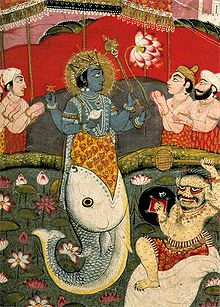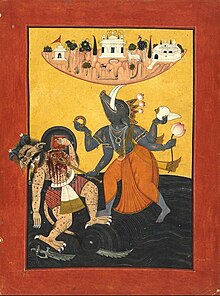Avatar: Difference between revisions
fixed date |
|||
| Line 78: | Line 78: | ||
Although it is usual to speak of Vishnu as the source of the avataras, within the Vaishnavism branch of Hinduism Vishnu is only one divine being that manifests in form. In that tradition [[Narayana]], [[Vasudeva]] and Krishna are also seen as names denoting divine aspects which take avataric form.<ref name="Matchett" /> In addition there are other senses and shades of meaning of the term avatar within Hinduism. |
Although it is usual to speak of Vishnu as the source of the avataras, within the Vaishnavism branch of Hinduism Vishnu is only one divine being that manifests in form. In that tradition [[Narayana]], [[Vasudeva]] and Krishna are also seen as names denoting divine aspects which take avataric form.<ref name="Matchett" /> In addition there are other senses and shades of meaning of the term avatar within Hinduism. |
||
=== |
=== Expansions and Purusa avatars === |
||
Purusha avatars are sometimes described as the original avatars of Vishnu or Krishna within the Universe:<ref>[http://www.indiadivine.org/hinduism/articles/86/1/Avatar---Categories-of-Incarnations/ Avatar - Categories of Incarnations]</ref><ref name=autogenerated1>[http://www.gaudiya.com/index.php?topic=theology gaudiya.com - theology]</ref> |
Purusha avatars are sometimes described as the original avatars of Vishnu or Krishna within the Universe:<ref>[http://www.indiadivine.org/hinduism/articles/86/1/Avatar---Categories-of-Incarnations/ Avatar - Categories of Incarnations]</ref><ref name=autogenerated1>[http://www.gaudiya.com/index.php?topic=theology gaudiya.com - theology]</ref> |
||
Expansions |
|||
* Vasudeva |
* Vasudeva |
||
* [[Shesha|Sankarshan]] |
* [[Shesha|Sankarshan]] |
||
* [[Pradyumna]] |
* [[Pradyumna]] |
||
* [[Aniruddha]] |
* [[Aniruddha]] |
||
Purusa Avatars |
|||
* [[Maha Vishnu]] |
|||
* [[Garbhodakasayi Vishnu]] |
|||
* [[Ksirodakasayi Vishnu]] |
|||
=== Guna avatars === |
=== Guna avatars === |
||
Revision as of 10:20, 17 December 2009

In Hinduism, Avatar or Avatara (Devanagari अवतार, IAST avatāra, Sanskrit for "descent" viz., from heaven to earth, from the verbal root tṝ "to cross over") refers to a deliberate descent of a deity from heaven to earth, and is mostly translated into English as "incarnation", but more accurately as "appearance" or "manifestation", as it corresponds to the view of Docetism in Christian theology, as distinct from the idea of incarnation in mainstream Christology and its implication of God 'in the flesh'.[1] The term is most often associated with Vishnu, though it has also come to be associated with other deities.[2]
Varying lists of avatars of Vishnu appear in Hindu scriptures, including the ten (daśāvatāra) of the Garuda Purana and the twenty-two avatars in the Bhagavata Purana, though the latter adds that the incarnations of Vishnu are innumerable.[3] The avatars of Vishnu are a primary component of Vaishnavism. While Vishnu is typically spoken of as the source of the avatars, in Vaishnavism, Narayana, Vasudeva, and Krishna are also described as the source. While Shiva and Ganesha are also described as descending in the form of avatars, with the Ganesha Purana and the Mudgala Purana detailing Ganesha's avatars specifically, the avatars of Vishnu carry a greater theological prominence than those of Shiva or Ganesha and upon examination relevant passages are directly imitative are imitative of the earlier Vishnu avatar lists.[1][4]
One of the earliest references to avatar is in the Bhagavad Gita (c. 3138 BCE), which describes the typical role of an avatar of Vishnu—to bring dharma, or righteousness, back to the social and cosmic order:[1][2]
Whenever righteousness wanes and unrighteousness increases I send myself forth.
In order to protect the good and punish the wicked,
In order to make a firm foundation for righteousness,
I come into being age after age. (4.7–8)
Avatars of Vishnu
The most traditional form of Avatar within Hinduism is the descents of Vishnu, the preserver or sustainer aspect of God within the Hindu Trinity or Trimurti.
Dasavatara: Ten Avatars of Vishnu in the Garuda Purana


| Part of a series on |
| Hinduism |
|---|
 |
The ten most famous descents of Vishnu are collectively known as the Dasavatara (Sanskrit: ten avatars). This list is included in the Garuda Purana (1.86.10"11) and denotes those avatars most prominent in terms of their influence on human society.[5]
The first four are said to have appeared in the Satya Yuga (the first of the four Yugas or ages in the time cycle described within Hinduism). The next three avatars appeared in the Treta Yuga, the eighth descent in the Dwapara Yuga and the ninth in the Kali Yuga. The tenth, Kalki, is predicted to appear at the end of the Kali Yuga.[6]
- Matsya, the fish, appeared in the Satya Yuga.
- Kurma, the tortoise, appeared in the Satya Yuga.
- Varaha, the boar, appeared in the Satya Yuga.
- Narasimha, the half man/half lion appeared in the Satya Yuga.
- Vamana, the dwarf, appeared in the Treta Yuga.
- Parashurama, Rama with the axe, appeared in the Treta Yuga.
- Rama, Ramachandra, the prince and king of Ayodhya, appeared in the Treta Yuga.
- Krishna (meaning "dark coloured" or "all attractive") appeared in the Dwapara Yuga along with his brother Balarama. According to the Bhagavata Purana, Balarama is said to have appeared in the Dwapara Yuga (along with Krishna) as a descent of Ananta Shesha. He is also counted as an avatar of Vishnu by the majority of Vaishnava movements and is included as the eighth Dasavatara in some versions of the list which contain no reference to Buddha.
- Gautama Buddha (meaning "the enlightened one") appeared in the Kali Yuga (specifically as Siddhartha Gautama).
- Kalki ("Eternity", or "time", or "The Destroyer of foulness"), who is expected to appear at the end of Kali Yuga.
Avatars of Vishnu in the Bhagavata Purana
Twenty-two avatars of Vishnu are listed numerically in the first Canto of the Bhagavata Purana as follows:[7]
- Four Kumaras [BP 1.3.6] (The Four Sons of Brahma)
- Varaha [BP 1.3.7] (The boar)
- Narada [BP 1.3.8] (The Traveling Sage)
- Nara-Narayana [BP 1.3.9] (The Twins)
- Kapila [BP 1.3.10] (The Philosopher)
- Dattatreya [BP 1.3.11] (Combined Avatar of The Trimurti)
- Yajna [BP 1.3.12] (Vishnu temporarily taking the role of Indra)
- Rishabha [BP 1.3.13] (Father of King Bharata and Bahubali)
- Prithu [BP 1.3.14] (King who made earth Beautiful and Attractive)
- Matsya [BP 1.3.15] (The Fish)
- Kurma [BP 1.3.16] (The Tortoise)
- Dhanvantari [BP 1.3.17] (Father of Ayurveda)
- Mohini [BP 1.3.17] (Beautiful/Charming Woman)
- Narasimha [BP 1.3.18] (The Man-Lion)
- Vamana [BP 1.3.19] (The Dwarf)
- Parasurama [BP 1.3.20] (The Rama with an Axe)
- Vyasa [BP 1.3.21] (Compiler of the Vedas)
- Rama [BP 1.3.22] (The King of Ayodhya)
- Balarama [BP 1.3.23] (Krishna's Elder Brother)
- Krishna [BP 1.3.23] (The Cowherd also Svayam Bhagavan)
- Buddha [BP 1.3.24] (The Enlightened)
- Kalki [BP 1.3.25] (The Destroyer)
Besides these, another four avatars are described later on in the text as follows:
- Prshnigarbha [BP 10.3.41] (Born to Prshni)
- Hayagriva [BP 2.7.11] (The Horse)
- Hamsa [BP 11.13.19] (The Swan)
- Golden avatra [BP 11.5.32] (Avatara in Kali-yuga for propagating hari-namasankirtan)
Chaitanya Mahaprabhu, who was born in the 15th century, is widely worshiped as the Golden Avatar, especially by followers of the Gaudiya Vaishnava tradition, referring to a number of texts from the Mahabharata, Upanishads, and other Puranic scriptures ([1]).
After Kalki avatar is described in the Bhagavata Purana it is declared that the avatars of Vishnu are innumerable.'[8] However the above list of twenty six avatars is generally taken as of those of greatest significance.
Other kinds of avatars within Vaishnavism
Although it is usual to speak of Vishnu as the source of the avataras, within the Vaishnavism branch of Hinduism Vishnu is only one divine being that manifests in form. In that tradition Narayana, Vasudeva and Krishna are also seen as names denoting divine aspects which take avataric form.[1] In addition there are other senses and shades of meaning of the term avatar within Hinduism.
Expansions and Purusa avatars
Purusha avatars are sometimes described as the original avatars of Vishnu or Krishna within the Universe:[9][10]
Expansions
- Vasudeva
- Sankarshan
- Pradyumna
- Aniruddha
Purusa Avatars
Guna avatars
The personalities of the Trimurti (Hindu trinity) are also sometimes referred to as Guna avatars, because of their roles of controlling the three modes (gunas) of nature,[10] even though they have not descended upon an earthly planet in the general sense of the term 'avatar'.
- Vishnu - As controller of the mode of goodness (sattva)
- Brahma - Controller of the mode of passion and desire (rajas)
- Shiva - Controller of the mode of ignorance (tamas)
Manvantara avatars
Manvantara avatars are beings responsible for creating progeny throughout the Universe, said to be unlimited in number.[11] They do not take birth.
Shaktyavesa and Avesa avatars
Avataric incarnations are classified as two kinds
- direct (sakshat)
- indirect (avesa).
When Vishnu himself descends, he is called sakshat or shaktyavesa-avatara, a direct incarnation of God. But when he does not incarnate directly, but indirectly empowers some living entity to represent him, that living entity is called an indirect or avesa avatar.[12]
There are said to be a great number of avesa avatars. Examples include Narada, Shakyamuni Buddha, and Parashurama. Parashurama is the only one of the traditional ten avatars that is not a direct descent of Vishnu.
According to the Sri Vaishnavism sect of Hinduism, there are two types of primary or direct avatars, Purna avatars and Amsarupavatars:
- Purna avatars are those in which Vishnu takes form directly and all the qualities and powers of God are expressed, (e.g. Narasimha, Rama and Krishna).[13]
- Amsarupavatars are those in which Vishnu takes form directly but He is manifest in the person only partially. (e.g. avatars from Matsya to Parashurama).
The avesa or indirect avatars are generally not worshiped as the Supreme being. Only the direct, primary avatars are worshiped in this way. In practice, the direct avatars that are worshiped today are the Purna avatars of Narasimha, Rama and Krishna. Among most Vaishnava traditions, Krishna is considered to be the highest Purna avatar. However, followers of Chaitanya (including ISKCON), Nimbarka, and Vallabha Acharya differ philosophically from other Vaishnavas, such as Ramanujacharya and Madhvacharya, and consider Krishna to be the ultimate Godhead, not simply an avatar. That said, all Hindus believe that there is no difference between worship of Vishnu and his avatars as it all leads to Him. According to Madhvacharya (chief proponent of Dvaita or school of differential monism), all avatars of Vishnu are alike in potency and every other quality. There is no gradation among them, and perceiving or claiming any differences among avatars is a cause of eternal damnation. See Madhva's commentary on Katha Upanishad, or his Mahabharata-Tatparya-Nirnaya.
See also
- Avatars in Mahabharata
- Gautama Buddha in Hinduism
- Hindu deities
- List of avatar claimants
- Svayam bhagavan
References
- ^ a b c d Matchett, Freda (2001). Krishna, Lord or Avatara?: the relationship between Krishna and Vishnu. 9780700712816. p. 4.
- ^ a b Kinsley, David (2005). Lindsay Jones (ed.). Gale's Encyclopedia of Religion. Vol. 2 (Second Edition ed.). Thomson Gale. pp. 707–708. ISBN 0-02-865735-7.
{{cite book}}:|edition=has extra text (help) - ^ Bryant, Edwin Francis (2007). Krishna: A Sourcebook. Oxford University Press US. p. 18. ISBN 9780195148916.
- ^
- For the four Ganesha incarnations in Ganesha Purana are given in John A. Grimes. Ganapati: Song of the Self. pp. 100-105. (State University of New York Press: Albany, 1995) ISBN 0-7914-2440-5
- For the eight incarnations in Mudgala Purana, see John A. Grimes pp. 105-110
- ^ Garuda Purana (1.86.10–11)
- ^ Matchett, p. 86.
- ^ Bhag-P 1.3 Canto 1, Chapter 3
- ^ Bhag-P 1.3.26
- ^ Avatar - Categories of Incarnations
- ^ a b gaudiya.com - theology
- ^ Avatar - Categories of Incarnations, by Atmatattva Das, 06/17/2005
- ^ Teachings of Lord Chaitanya - Avatars
- ^ Types of Avatars; answers to questions #67-70.

